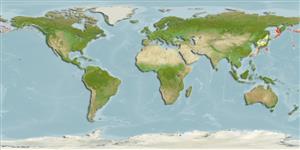Klassifizierung / Names
Namen | Synonyme | Catalog of Fishes(Gattung, Arten) | ITIS | CoL | WoRMS | Cloffa
>
Perciformes/Cottoidei (Sculpins) >
Liparidae (Snailfishes)
Etymology: Careproctus: Greek, kara = face + Greek, proktos = anus (Ref. 45335); lycopersicus: Named for the tomato plant, Solanum lycopersicum, meaning ‘wolf peach'; referring to its typically bright red tomato-like coloration..
Environment: milieu / climate zone / depth range / distribution range
Ökologie
seewasser bathydemersal; tiefenbereich 397 - 1157 m (Ref. 91047). Temperate
North Pacific: Bering Sea and the eastern Aleutian Islands.
Size / Gewicht / Alter
Maturity: Lm ? range ? - ? cm
Max length : 13.3 cm TL Männchen/unbestimmt; (Ref. 91047); 17.2 cm TL (female)
Kurzbeschreibung
Morphologie | Morphometrie
Rückenflossenweichstrahlen (insgesamt): 42-45; Afterflossenweichstrahlen: 34 - 38; Wirbelzahl: 45 - 50. This species is distinguished from its congeners by the following characters: premaxilla and dentary with broad rows of strongly trilobed teeth (vs. simple or weakly trilobed teeth on both jaws); the large gill opening extends ventrally to pectoral rays 8-12 (vs. smaller above the pectoral fin or extending to less than five pectoral-fin rays); large pelvic disk greater or equal 30% head length (vs. smaller pelvic disk, < 25% HL); most similar to C. ovigerus, which can be distinguished from C. lycopersicus by its simple, canine teeth on both jaws, and to C. kamikawai, which is distinguished by its subterminal mouth, slight dorsal-fin lobe, black peritoneum, smaller pelvic disc, slender caudal base, and more anterior position of the pelvic disc, anus, and anal-fin origin (Ref. 91047).
One 11.6 cm TL ripe male and female specimens were examined: the smallest female with yolked eggs was 14.9 cm (UW 119817). For the ripe females, at least two sizes of eggs were present, yolked eggs were 3.5 mm in diameter and smaller white eggs had diameters of 0.5-1.5 mm (Ref. 91047).
Life cycle and mating behavior
Geschlechtsreife | Fortpflanzung | Ablaichen | Eier | Fecundity | Larven
Orr, J.W., 2012. Two new species of snailfishes of the genus Careproctus (Scorpaeniformes: Liparidae) from the Bering Sea and Eastern North Pacific Ocean, with a redescription of Careproctus ovigerus. Copeia 2012(2):257-265. (Ref. 91047)
IUCN Rote Liste Status (Ref. 130435)
Bedrohung für Menschen
Harmless
Nutzung durch Menschen
Mehr Information
NamenSynonymeMetabolismusRäuberÖkotoxikologieFortpflanzungGeschlechtsreifeAblaichenSpawning aggregationFecundityEierEientwicklung
Alter/GrößeWachstumLänge-GewichtLänge-LängeLängenhäufigkeitenMorphometrieMorphologieLarvenLarven Pop.Dyn.RekrutierungDichteBRUVS
ReferenzenAquakulturAquakultur ProfilZuchtlinienGenetikElectrophoresesVererbbarkeitKrankheitenVerarbeitungNutrientsMass conversion
PartnerBilderStamps, Coins Misc.LauteCiguateraGeschwindigkeitSchwimmstilKiemenoberflächeOtolithsGehirngrößeSehfähigkeit
Tools
Zusatzinformationen
Download XML
Internet Quellen
Estimates based on models
Preferred temperature (Ref.
123201): 2 - 3.5, mean 3.3 °C (based on 22 cells).
Phylogenetic diversity index (Ref.
82804): PD
50 = 0.5000 [Uniqueness, from 0.5 = low to 2.0 = high].
Bayesian length-weight: a=0.00447 (0.00204 - 0.00980), b=3.17 (2.99 - 3.35), in cm total length, based on LWR estimates for this Genus-body shape (Ref.
93245).
Trophic level (Ref.
69278): 3.2 ±0.5 se; based on size and trophs of closest relatives
Widerstandsfähigkeit (Ref.
120179): hoch, Verdopplung der Population dauert weniger als 15 Monate. (Preliminary K or Fecundity.).
Fishing Vulnerability (Ref.
59153): Low vulnerability (10 of 100).
